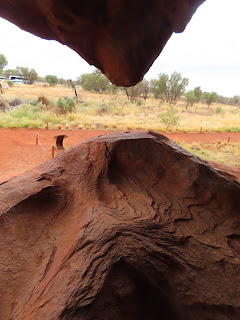Our day began very early. A 4:30 AM alarm was set so we could be at the bus stop at 5 AM. Darkness and a cold wind gave us a blast of "wake up" as we left the apartment. This was necessary to be able to see the sun rise over the Australian outback and shine its light on Uluru. This massive sandstone monolith rises over 1141 feet above the ground. There is some disagreement as to its status of the largest rock in the world, but it is freestanding and so there is some credence to the claim. It is actually like an iceberg as an additional 5 km of rock lies below ground level. The trail that goes completely around it is over 10 km long. We only did two trails, the Mala Walk and the Kuniya Walk. We did drive all the way around it. There are sections that are closed to photography much like the sacred areas in a cathedral or a mosque. The origin stories of the Anangu are written on the faces of Uluru and that is why some sections are very sensitive. Jack was our guide and he told us of three stories of the Anangu as we rounded Uluru. The first was of a blue tonged skink man who was greedy and ate an Emu that other hunters had already speared. Another told the tale of two different groups coming into conflict and the third was a battle between a python woman and a brown snake man. Each story has a moral and lessons to be learned. There were also distinct features on the rock face that highlighted important aspects of each tale.
Thick clouds as we got to the top of the dune
Our 4x4 vehicle
A blustery morning
The sun warmed us up a little
Warm tea and hot breakfast sandwiches helped too
Arriving right on time, the sun
Our guide Jack
The red sand of the local terrain
Our first view as we got closer
From the car Jack begins his first story from the local peoples
Time to get out and get close
It is really much taller than we thought it would be. The shiny bit on the right hand side is the grey scar. It is where people used to climb up. It was a dangerous climb and 36 people have died while attempting the climb. Climbing is no longer allowed.
We start the Mala walk. The mala were rock kangaroos which are no longer found in the area but are being bred in hopes of reintroducing them
It is very rugged
All the dark streaks are places where the rain from last night is still seeping through the porous rock
Fresh Flows
Uluru is looking back at us
It is unusual to get to see the water flowing
But we get lucky again
So many holes
Right next to the Old Peoples Cave, no climbing required and nice and sheltered.
Caves are everywhere on this sandstone monolith
The Kantju Gorge
Kantju Canyon is huge
\
Rock art used to teach the young ones
Red ochre and clay pigments
Part of the oral tradition of the original people
It was full of figures
It was also sheltered from the wind and sun
All of the waterholes were sacred and visitors were supposed to be quiet
The smallest of waterfalls
An odd formation
This overhang was sacred and told another story
These ancestors were killed by a shape shifter
And they are still to be seen in the rock face
Areas where the grain was ground
More rock art
I wonder, termites, moles???
The waterhole at the gorge
The trees love this spot
It has been 148 days since we began our Migration









































